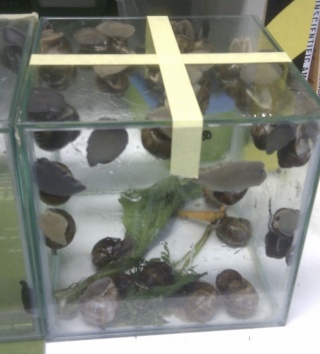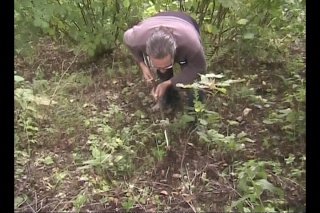Urban Cuisine
Contents
Session 1 - Snails of Ljubljana, September 2013
Tools needed
- plastic bag
- (optional: a wooden stick)
Links on heliciculture
The French must know... http://www.gireaud.net/us/heliciculture_us.htm
Nutrional value of snail.....http://www.dietaryfiberfood.com/protein/snail-escargot.php
Snail pie is much more nutritious than a beef pie... http://www.sciencedaily.com/releases/2009/11/091119101207.html
informative video about snails picking, preparation and cooking. For now only in slovenian language; http://www.youtube.com/watch?v=YPkDli0Q75c&feature=c4-overview&list=UU6yDRhma1AY_1YM4Z1rVhcA.
Session 2: Nutria
see some first expeditions on hackteria website
Experiences
Nutria is active at late afternoon. This is time when they get out of there holes at river dock. They love apples. Be patient they will come. Nutria is not disturbed by sound or light not even present of hunter but rapid gesture will make her go in to water. Boat is probably very efficient way to hunt nutria if you don't have gun. Since they usually swim to other side of the river is good practice to position two hunters on both sides of canal. Don't forget cigarettes and beer when going on other side of the river.
Trapping
http://www.youtube.com/watch?v=b-3Wp9F3mP4
http://kieferle.com/jagdbedarf/totschlagfallen/mittlere-tiere/00023.php
hunting and eating
http://www.wwltv.com/news/Golden-Meadow-to-hold-nutria-hunting-rodeo-134394308.html
General Biology, Reproduction, and Behavior
more info about Nutria from http://icwdm.org/handbook/rodents/nutria.asp
Habitat
Nutria adapt to a wide variety of environmental conditions and persist in areas previously claimed to be unsuitable. In the United States, farm ponds and other freshwater impoundments, drainage canals with spoil banks, rivers and bayous, freshwater and brackish marshes, swamps, and combinations of various wetland types can provide a home to nutria. Nutria habitat, in general, is the semiaquatic environment that occurs at the boundary between land and permanent water. This zone usually has an abundance of emergent aquatic vegetation, small trees, and/or shrubs and may be interspersed with small clumps and hillocks of high ground. In the United States, all significant nutria populations are in coastal areas, and freshwater marshes are the preferred habitat.
Food Habits
Nutria are almost entirely herbivorous and eat animal material (mostly insects) incidentally, when they feed on plants. Freshwater mussels and crustaceans are occasionally eaten in some parts of their range. Nutria are opportunistic feeders and eat approximately 25% of their body weight daily. They prefer several small meals to one large meal.
The succulent, basal portions of plants are preferred as food, but nutria also eat entire plants or several different parts of a plant. Roots, rhizomes, and tubers are especially important during winter. Important food plants in the United States include cordgrasses (Spartina spp.), bulrushes (Scirpus spp.), spikerushes (Eleocharis spp.), chafflower (Alternanthera spp.), pickerelweeds (Pontederia spp.), cattails (Typha spp.), arrowheads (Sagittaria spp.), and flatsedges (Cyperus spp.). During winter, the bark of trees such as black willow (Salix nigra) and bald-cypress (Taxodium distichum) may be eaten. Nutria also eat crops and lawn grasses found adjacent to aquatic habitat.
Because of their dexterous forepaws, nutria can excavate soil and handle very small food items. Food is eaten in the water; on feeding platforms constructed from cut vegetation; at floating stations supported by logs, decaying mats of vegetation, or other debris; in shallow water; or on land. In some areas, the tops of muskrat houses and beaver lodges may also be used as feeding platforms.
General Biology
In the wild, most nutria probably live less than 3 years; captive animals, however, may live 15 to 20 years. Predation, disease and parasitism, water level fluctuations, habitat quality, highway traffic, and weather extremes affect mortality. Annual mortality of nutria is between 60% and 80%.
Predators of nutria include humans (through regulated harvest), alligators (Alligator mississippiensis), garfish (Lepisosteus spp.), bald eagles (Haliaeetus leucocephalus), and other birds of prey, turtles, snakes such as the cottonmouth (Agkistrodon piscivorus), and several carnivorous mammals.
Nutria densities vary greatly. In Louisiana, autumn densities of about 18 animals per acre (44/ha) have been found in floating freshwater marshes. In Oregon, summer densities in freshwater marshes may be 56 animals per acre (138/ha). Sex ratios range from 0.6 to 1.6 males per female.
In summer, nutria live on the ground in dense vegetation, but at other times of the year they use burrows. Burrows may be those abandoned by other animals such as armadillos (Dasypus novemcinctus), beavers, and muskrats, or they may be dug by nutria. Underground burrows are used by individuals or multigenerational family groups.
Burrow entrances are usually located in the vegetated banks of natural and human-made waterways, especially those having a slope greater than 45o. Burrows range from a simple, short tunnel with one entrance to complex systems with several tunnels and entrances at different levels. Tunnels are usually 4 to 6 feet (1.2 to 1.8 m) long; however, lengths of up to 150 feet (46 m) have been recorded. Compartments within the tunnel system are used for resting, feeding, escape from predators and the weather, and other activities. These vary in size, from small ledges that are only 1 foot (0.3 m) across to large family chambers that measure 3 feet (0.9 m) across. The floors of these chambers are above the water line and may be covered with plant debris discarded during feeding and shaped into crude nests.
In addition to using land nests and burrows, nutria often build flattened circular platforms of vegetation in shallow water. Constructed of coarse emergent vegetation, these platforms are used for feeding, loafing, grooming, birthing, and escape, and are often misidentified as muskrat houses. Initially, platforms may be relatively low and inconspicuous; however, as vegetation accumulates, some may attain a height of 3 feet (0.9 m).
Reproduction
Nutria breed in all seasons throughout most of their range, and sexually active individuals are present every month of the year. Reproductive peaks occur in late winter, early summer, and mid-autumn, and may be regulated by prevailing weather conditions.
Under optimal conditions, nutria reach sexual maturity at 4 months of age. Female nutria are polyestrous, and nonpregnant females cycle into estrus (“heatâ€) every 2 to 4 weeks. Estrous is maintained for 1 to 4 days in most females. Sexually mature males can breed at any time because sperm is produced throughout the year.
The gestation period for nutria ranges from 130 to 132 days. A postpartum estrus occurs within 48 hours after birth and most females probably breed again during that time.
Litters average 4 to 5 young, with a range of 1 to 13. Litter sizes are generally smaller during winter, in suboptimal habitats, and for young females. Females often abort or assimilate embryos in response to adverse environmental conditions.
Young are precocial and are born fully furred and active. They weigh approximately 8 ounces (227 g) at birth and can swim and eat vegetation shortly thereafter. Young normally suckle for 7 to 8 weeks until they are weaned.
Behavior
Nutria tend to be crepuscular and nocturnal, with the start and end of activity periods coinciding with sunset and sunrise, respectively. Peak activity occurs near midnight. When food is abundant, nutria rest and groom during the day and feed at night. When food is limited, daytime feeding increases, especially in wetlands free from frequent disturbance.
Nutria generally occupy a small area throughout their lives. In Louisiana, the home range of nutria is about 32 acres (13 ha). Daily cruising distances for most nutria are less than 600 feet (183 m), although some individuals may travel much farther. Nutria move most in winter, due to an increased demand for food. Adults usually move farther than young. Seasonal migrations of nutria may also occur. Nutria living in some agricultural areas move in from marshes and swamps when crops are planted and leave after the crops are harvested.
Nutria have relatively poor eyesight and sense danger primarily by hearing. They occasionally test the air for scent. Although they appear to be clumsy on land, they can move with surprising speed when disturbed. When frightened, nutria head for the nearest water, dive in with a splash, and either swim underwater to protective cover or stay submerged near the bottom for several minutes. When cornered or captured, nutria are aggressive and can inflict serious injury to pets and humans by biting and scratching.
General Links and Ideas about urban hunting
Nutria
Nutria is active at late afternoon. This is time when they get out of there holes at river dock. They love apples. Be patient they will come. Nutria is not disturbed by sound or light not even present of hunter but rapid gesture will make her go in to water. Boat is probably very efficient way to hunt nutria if you don't have gun. Since they usually swim to other side of the river is good practice to position two hunters on both sides of canal. Don't forget cigarettes and beer when going on other side of the river.

